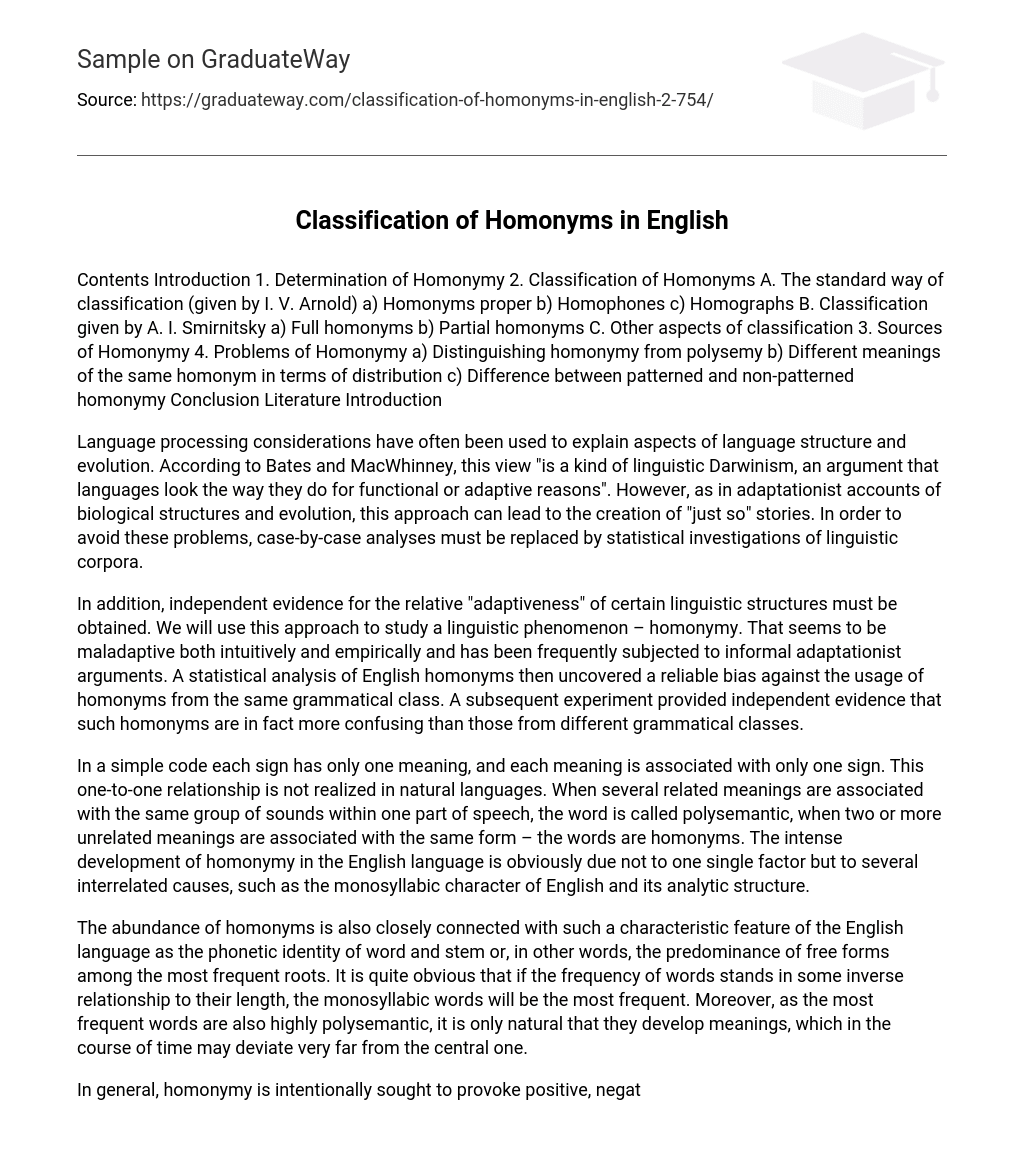Language processing considerations have often been used to explain aspects of language structure and evolution. According to Bates and MacWhinney, this view “is a kind of linguistic Darwinism, an argument that languages look the way they do for functional or adaptive reasons”. However, as in adaptationist accounts of biological structures and evolution, this approach can lead to the creation of “just so” stories. In order to avoid these problems, case-by-case analyses must be replaced by statistical investigations of linguistic corpora.
In addition, independent evidence for the relative “adaptiveness” of certain linguistic structures must be obtained. We will use this approach to study a linguistic phenomenon – homonymy. That seems to be maladaptive both intuitively and empirically and has been frequently subjected to informal adaptationist arguments. A statistical analysis of English homonyms then uncovered a reliable bias against the usage of homonyms from the same grammatical class. A subsequent experiment provided independent evidence that such homonyms are in fact more confusing than those from different grammatical classes.
In a simple code each sign has only one meaning, and each meaning is associated with only one sign. This one-to-one relationship is not realized in natural languages. When several related meanings are associated with the same group of sounds within one part of speech, the word is called polysemantic, when two or more unrelated meanings are associated with the same form – the words are homonyms. The intense development of homonymy in the English language is obviously due not to one single factor but to several interrelated causes, such as the monosyllabic character of English and its analytic structure.
The abundance of homonyms is also closely connected with such a characteristic feature of the English language as the phonetic identity of word and stem or, in other words, the predominance of free forms among the most frequent roots. It is quite obvious that if the frequency of words stands in some inverse relationship to their length, the monosyllabic words will be the most frequent. Moreover, as the most frequent words are also highly polysemantic, it is only natural that they develop meanings, which in the course of time may deviate very far from the central one.
In general, homonymy is intentionally sought to provoke positive, negative or awkward connotations. Concerning the selection of initials, homonymy with shortened words serves the purpose of manipulation. The demotivated process of a shortened word hereby leads to re-motivation. The form is homonymously identical with an already lexicalized linguistic unit, which makes it easier to pronounce or recall, thus standing out from the majority of acronyms. This homonymous unit has a secondary semantic relation to the linguistic unit.
Homonymy of names functions as personified metaphor with the result that the homonymous name leads to abstraction. The resultant new word coincides in its phonological realization with an existing word in English. However, there is no logical connection between the meaning of the acronym and the meaning of the already existing word, which explains a great part of the humor it produces. In the course of time the number of homonyms on the whole increases, although occasionally the conflict of homonyms ends in word loss. Determination of Homonymy
Two or more words identical in sound and spelling but different in meaning, distribution and in many cases origin are called homonyms. The term is derived from Greek “homonymous” (homos – “the same” and onoma – “name”) and thus expresses very well the sameness of name combined with the difference in meaning. There is an obvious difference between the meanings of the symbol fast in such combinations as run fast ‘quickly’ and stand fast ‘firmly’. The difference is even more pronounced if we observe cases where fast is a noun or a verb as in the following proverbs: “A clean fast is better than a dirty breakfast;
Who feasts till he is sick, must fast till he is well. ” Fast as an isolated word, therefore, may be regarded as a variable that can assume several different values depending on the conditions of usage, or, in other words distribution. All the possible values of each linguistic sign are listed in the dictionaries. It is the duty of lexicographers to define the boundaries of each word, i. e. to differentiate homonyms and to unite variants deciding in each case whether the different meanings belong to the same polysemantic word or whether there are grounds to treat them as two or more separate words identical in form.
In speech, however, as a rule only one of all the possible values is determined by the context, so that no ambiguity may normally arise. There is no danger, for instance, that the listener would wish to substitute the meaning ‘quick’ into the sentence: It is absurd to have hard and fast rules about anything, or think that fast rules here are ‘rules of diet’.
Combinations when two or more meanings are possible are either deliberate puns, or result from carelessness. Both meanings of liver, i. e. ‘a living person’ and ‘the organ that secretes bile’ are, for instance, intentionally “Is life worth living? ”It depends upon the liver. ” present in the following play upon words: “What do you do with the fruit? ” “We eat what we can, and what we can’t eat we can” Very seldom can ambiguity of this kind interfere with understanding.
The following example is unambiguous, although the words back and part have Arnold “The English Word”, Oscar Wild “Two Society Comedies” several homonyms, and maid and heart are polysemantic: “Maid of Athens, ere we part, Give, oh give me back my heart”1 Homonymy exists in many languages, but in English it is particularly frequent, especially among monosyllabic words.
In the list of 2540 homonyms given in the “Oxford English Dictionary” 89% are monosyllabic words and only 9. 1% are words of two syllables. From the viewpoint of their morphological structure, they are mostly one-morpheme words.





